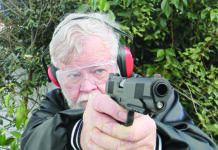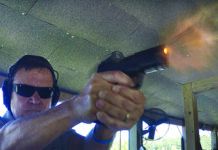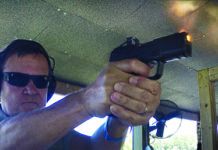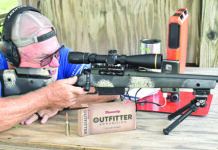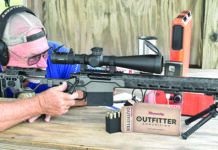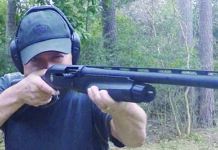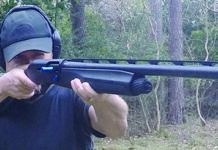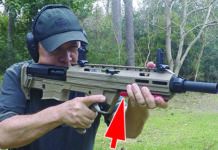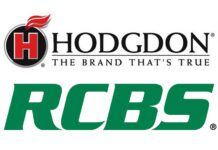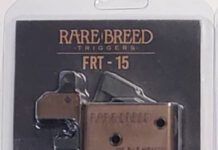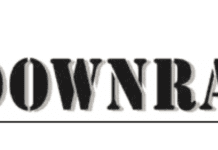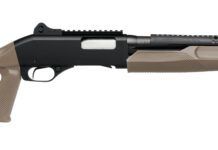The adage of “Beware of the one who uses a single gun” can be applied to quite a few firearm fanciers who favor an all-around shotgun to fulfill their various needs in the home and field. Since the legendary Winchester Model 12 pump-action shotgun dominated the market in days of old, slide-actions have been a favorite shooting tool of those who might touch off a couple of boxes of ammunition a year as well as to many wingshots and target busters who buy their shells by the pallet. Pump-action shotguns have a well-earned reputation of performing in all kinds of conditions and shooting situations where reliability is not an option, it is a necessity.
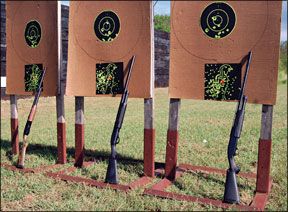
Shooters who use their one gun for all types of service are normally proficient in putting their firearm to good use. Being familiar with the way the multi-use shotgun handles and performs is a big plus in filling a game bag or defending the homestead.
The fact that pumps, particularly those that can be found in the used-gun racks of sporting goods stores across the country, carry price tags in the low to moderate range is another factor adding to their popularity. Picking up a good shooting tool for under $500 is a satisfying accomplishment in most hunting and shooting circles.
Our trip to the used-gun rack resulted in the selection of three popular makes and models of pump-action shotguns for testing on the patterning range and in the field. We were looking for models that were all capable of performing multiple service, such as self-defense firearms in a home; good-patterning short-range shotguns for turkeys; and adequate performance on clay targets or even wingshooting situations such as in the dove field.
We selected a Browning BPS Stalker Composite No. 012212305 3-inch 12 Gauge with a price tag of $500, a Remington Model 870 Express Super Magnum Synthetic No. 25102 3.5-inch 12 Gauge, $300; and a Winchester Model 1300 Turkey Win-Cam with a price tag of $400. All of the shotguns were in good to very good condition and showed little sign of wear and no indication of abuse by their former owners. Buyers of used firearms are advised to always be cautious in their purchase, as no one wants to pay good money to be stuck with someone elses problems.
As experienced slide-action shooters are aware, pumps are not known for the fine balance and handling ability of high-end shotguns like the over-and-unders or semi-automatics used by top-gun clay-target competitors. However, they work well as dependable field guns where the shooter is attempting to fill a game bag in rough-and-tumble conditions. Pump-actions tend to be more of a workhorse than a racehorse, and that is why a lot of everyday shooters and hunters are willing to part with a few dollars to put them into their shooting tool collection.
To check out the shotguns in a variety of shooting situations, we selected the following test ammunition:
For clay targets, we used Winchester Super X 2.75-inch Game Loads with 1 ounce of No. 7.5 shot and an average muzzle velocity of 1290 fps. For turkey targets, we tried out Federal Premium Mag-Shok 3-inch loads with 2 ounces of No. 4 shot and an average muzzle velocity of 1300 fps. For home defense, we fired both Remington Express Buckshot 2.75-inch loads with 12 pellets of 00 buckshot and an average muzzle velocity of 1325 fps and Winchester Super X 2.75-inch loads with 1-ounce rifled hollow-point slugs and an average muzzle velocity of 1600 fps.
Since the Remington was the only one of the trio that would handle 3.5-inch ammunition, we limited our testing to the 2.75- and 3-inch shells. If handling the largest 12-gauge shells is important to you, then scale the 870s grade up as you deem appropriate.
The results of our trip to the patterning range were all acceptable, although we noted that the Winchester really seemed to shine with the turkey loads and produced an exceptional number of kill shots on the Shoot-N-C Turkey Silhouette Targets. Details of how each shotgun performed on the range and in the field follow:
Browning BPS Stalker Composite
No. 012212305 3-inch 12 Gauge, $500
One of the more affordable guns in the Browning shotgun lineup, our test 26-inch model is still in the companys catalog, selling for $579 suggested retail. The $500 price reflects what was on the hang tag at Durys Gun Shop in San Antonio (www.DurysGuns.com).

Like most Browning products, the pump-action shotgun manufactured by the company has a quality feel and design that has found favor with a huge number of hunters and shooters. Although slide-action shotguns are not known for their balance, we liked the feel and heft of the Browning from the first time our staff picked it up from the used-gun rack. When snuggled into the shooters shoulder, the Browning was easily the most comfortable of the trio of test guns, our testers said. The longest of the three, the Browning had an overall length of 46.5 inches, with a length of pull of 14 inches. Featuring a drop at the comb of 1.25 inches and a drop at the heel of 2.25 inches, the composite stock provided a good fit for all members of our test team.
One of the first plus factors we noted was the ambidextrous safety on the top of the receiver. Combined with the bottom ejection system-one of the few such systems in the pump-action world-this shotgun is truly a firearm that fits both right-handed shooters and lefties. We also put a check mark on the plus side of our ledger for the Hi-Viz red-bar front sight that had been installed on the Browning. Not a big factor in shooting clay targets, the red sight did provide a better shooting platform for acquiring paper targets and would provide good service in turkey hunting conditions or as a home-defense gun. Yet another plus for the Browning was the trigger pull, with the break occurring at about 6 pounds, well within the favored range of most shotgun enthusiasts.
On the clay-target range and in the dove-hunting field, the Browning excelled. Even with the 26-inch barrel, the shotgun moved through targets and birds with smooth ease, and spent shells were ejected with authority in all conditions. From the 2.75-inch loads to the heavy 3-inch loads, recoil was not considered excessive. Putting the shotgun to the patterning test confirmed the reason for our success in the field and on the clay range. At a range of 30 yards and using the modified choke, the Browning produced a perfect 50-50 pattern, with the pellet spread evenly distributed across the paper.
Switching to the buckshot loads (we removed the choke and moved up to a range of 20 paces for all the buckshot and slug tests), the 12 pellets were all contained in a 7-inch-diameter circle, and the slug shots were all in the X-ring. We were very pleased with the way the Browning performed in home-defense mode.
The turkey-load patterning was also very satisfying with the Browning, although like the other two shotguns, hits were a little lower than we would have liked. Once again, using the Modified choke and shooting targets set up at 30 yards, the Browning placed an average of 75 No. 4 pellets in the head, neck, heart, and lungs of the turkey. That type of killing pattern would assure a turkey hunter that the shotgun would do its part in filling a game bag.
Our Team Said: It was hard to find any downside to the Browning, which handled well, patterned well and performed in the field in a manner that exceeded our expectations. Although the Brownings price tag was the highest of the trio, we believe the few extra dollars would be well spent in picking up this pump that capably fills its role as an all-around shotgun.
Remington Model 870 Express Super Magnum
Synthetic No. 25102 3.5-inch 12 Gauge, $300
One of the veterans in the pump-shotgun market, the Remington Model 870 has a huge following among shotgunners across the nation and is known for getting the job done. The version we selected in our used-gun mission is among the less expensive models on the market, and its price tag caters to bargain-minded buyers. The manufacturers suggested retail price of a new Remington Model 870 Express Super Magnum Synthetic is $431.
Slightly more bulky than the Browning that also featured a 26-inch barrel, the heft and balance of the Remington was typical of most slide-action shotguns. With a length of pull of 13.75 inches and an overall length of 45.5 inches, it was slightly shorter and fit the smaller members of our test team just a little better. The drop at the comb of 1.25 inches and drop at the heel of 2 inches provided a little less drop than the Browning, which proved to be a non-factor on the shooting range.
Unfortunately, our first impression of handling ability carried over into the field and on the range, with the Remington failing to match the smoothness of the Browning. Several of our test team members noted that the balance of the Remington caused an irregular swing through crossing targets, and proper follow-through was not as effective as with the Browning, although both sported 26-inch barrels.
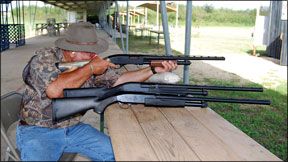
We also encountered a functioning problem with the Remington. About one time in every five or six shots, the Remingtons pump action would not allow the shooter to eject a spent shell. The forearm had to be shoved slightly forward before the shooter could work the action. Taking the shotgun apart and cleaning the action did not correct the problem.
This may have been the result of misuse by the previous owner or may require a simple adjustment by a gunsmith, but our test team had to put an X in the minus column of our review list because of the performance.
We were pleasantly surprised at the trigger pull of the Remington, which broke at 5 pounds. A light trigger pull, while not as big an issue with a shotgun as it is with a rifle, does make for a smoother function in shooting situations. If you want to improve the 870s trigger pull further, Brownells (www.brownells.com) sells a Timney Trigger Fix kit, which replaces the guns original factory sear and spring. The kit comes with three different spring weights to lower the factory trigger pull to 2, 3, or 4 pounds.
On the patterning range, the Remingtons performance trailed the other two shotguns with all of the test ammunition. Most disappointing was the pattern with the No. 71⁄2 game loads, which was about a 25-75 spread with the larger percentage of shot below the center of the target. This may have been a factor of using the modified choke, and patterning performance may be improved with the use of a different choke.
Patterns with buckshot and the slugs were also a little lower than we would have liked. The buckshot pattern at 20 paces with no choke in the barrel was about 8.5 inches in diameter and the slug hits were all outside the X ring.
Recoil with all the loads in the Remington was handled better than with the other two shotguns in the trio, and it should be noted that it was the only one capable of handling 3.5-inch shells.
Our Team Said: Balance and handling ability of the Remington was just average, and the patterning performance with all the test loads was less than satisfying. We believe there is some potential for this particular inexpensive pump to be a proper all-around shotgun, perhaps with a little gunsmith work to fine-tune the action, but we found it difficult to give it a good grade after our test run.
Winchester Model 1300 Turkey Win-Cam
3-inch 12 Gauge, $400
The tiniest of the trio, this Winchester shotgun was designed with turkey hunting in mind, and based on its performance on the patterning range, it lived up to expectations.
Last manufactured in 2006 and with a list price ranging from $444 to $514, the Turkey Win-Cam in our test trio featured a sporty laminated wood stock and forearm that really made it stand out from the black-composite pumps.
With its 22-inch barrel and overall length of 42.75 inches, the Winchester was a quick shotgun to swing into action, but it lacked the balance of the longer-barrel models in the test.
The drop at the comb of 1.25 inches and drop at heel of 2 inches, combined with a length of pull of 14 inches, provided for a comfortable fit for our test group, although even with its short length, we noted it felt slightly bulky.
Obviously, this shotgun is set up for turkey hunting situations more than for use as a wing-shooting or clay target tool. However, the short barrel also offers the user capable service as a self-defense firearm. As expected, the Winchester did not excel in the dove field or on the clay target range. We were able to hit some birds and break a few clays, but the smooth-wing factor was almost non-existent. This simply is not the type of shotgun a user would normally put into service for this kind of shooting as an all-around tool, although we found it will perform in an adequate manner.
Moving over to the patterning range, the Model 1300 showed its true worth. With the choke tube removed and firing shots at 20 paces, the Winchester consistently produced buckshot patterns of about 5 inches in diameter and regularly punched holes in the X-ring with slugs. It should be noted that recoil from the loads was quite harsh with the short gun.
At 30 yards and using the Modified choke, the Model 1300 smacked the turkey targets with authority, with an average of 100 No. 4 pellets in the kill zone. While we were very impressed with the shotgun performing the duty it was designed to handle, once again, the shoulder shock from touching off the shots was not very comfortable. In several cases, the recoil from a shot actually caused the Winchesters slide action to work itself and eject the spent shell.
Since most situations involving the turkey or self-defense loads are limited to one or two shots, we decided we could accept the Winchesters notable lack of recoil reduction. However, if a shooter plans to spend much time touching off heavy rounds with this shotgun, we recommend a trip to a gunsmith for some type of additional recoil reduction system.
Results with the No. 71⁄2 game loads were also satisfactory, with an average pattern of 40-60. Even with the majority of the shot pattern falling below the center of the target at 30 yards, this performance would produce a good killing pattern on birds and clays.
The Winchesters trigger pull weight of 7.75 pounds was also a concern in our test, as the heavy pull added to the anticipation time when firing a shot. Once again, our recommendation would be to give the shotgun a little gunsmith time to reduce the pull to a more acceptable range of about 5-6 pounds.
Our Team Said: Performing its function as a potential turkey hunting tool in an exceptional manner, the Winchester also provided good service as a self-defense shotgun and adequate duty in the field. We were disappointed in the shoulder shock from firing the shotgun and would recommend the installation of some additional type of recoil-reduction system and gunsmith work to reduce the trigger pull.



